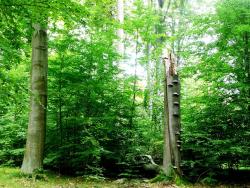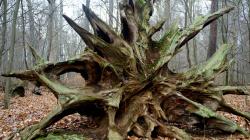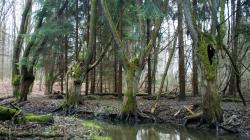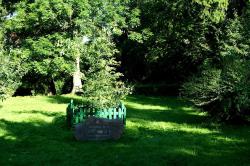 Asset Publisher
Asset Publisher
Polish forests
Poland is in the European lead, while concerning the area of all forests. They cover about 29,2 % of the country territory, and grow within the area of 9,1 million hectares. The overwhelming majority of the forests is state owned, of which almost 7,6 million hectares are managed by the State Forests National Forest Holding..
The number of Polish forest is still growing. The forestation rate of the country has increased from 21 % in 1945 to 29,2 % at the moment. Between 1995 and 2008, the forest area increased by 310 thousand ha. The basis for afforestation works is the "National Programme for Increasing the Forest Cover" (KPZL), assuming an increase of the forestation rate up to 30 % by 2020 and up to 33 % by 2050. Polish forests abound in flora, fauna and fungi. 65 % of the total number of animal species live there.
The forests grow in our country on poor soils, mainly because of the development of the agriculture in previous years. It influences the distribution of the types of the forest sites in Poland. Over 55 % of the forest areas is covered with coniferous forests. In other areas, there are forest sites, mainly the mixed ones. Their small part constitute alder and riparian forests – not more than 3 %.
In the years 1945 – 2011 the area of natural deciduous tree stands within the area of the State Forests National Forest Holding increased from 13 to 28,2 %.
Within the lowlands and uplands the most often occurring tee species is pine. It covers 64,3 % of the forest area of the State Forests National Forest Holding and 57,7 % of private and commune forests. In the mountains the predominant species is European spruce ( in the west) and European spruce with beech (in the east). Domination of pine is the result of carrying on sustainable forest management in the past. Once, the monocultures (crops or cultivations of one species) were the answer to the great demand of industry for wood. Such forests appeared to be quite fragile to climatic factors. They also were often the prey of pests' expansion.
In Polish forests, the share of other tree species, especially deciduous trees have been systematically increasing. The foresters have stepped aside from monocultures – that is why, they try to fit specific species of the forest stand to the natural stand, that would be proper for the given area. Thanks to that, in the years 1945 – 2011, the area of the deciduous tree stands within the lands of the State Forests National Forest Holding increased from 13 to 28,2 %. There occur more and more frequently the following tree species: oaks, ashes, maples, sycamore maples, elms, but also birches, beeches, alders, poplars, hornbeams, aspens, tilias and willows.
Our forests are the most often represented by the forest stands aged 40 to 80 years. The average age of the forest equals 60 years. More and more trees are of big size at the age over 80 years. Since the end of the Second World War, the forests' area has increased up to almost 1,85 million hectares.
Raport o stanie lasów w Polsce 2012
 Asset Publisher
Asset Publisher
 Asset Publisher
Asset Publisher
Tourist Attractions
Tourist Attractions
 Rezerwat przyrody "Annabrzeskie Wąwozy". Fot. Jerzy Wilanowski
Rezerwat przyrody "Annabrzeskie Wąwozy". Fot. Jerzy Wilanowski
 Lasy Nadleśnictwa Szprotawa. Fot. Sebastian Zapolski
Lasy Nadleśnictwa Szprotawa. Fot. Sebastian Zapolski
 Lasy Nadleśnictwa Szprotawa. Fot. Sebastian Zapolski
Lasy Nadleśnictwa Szprotawa. Fot. Sebastian Zapolski
 Lasy Nadleśnictwa Szprotawa. Fot. Sebastian Zapolski
Lasy Nadleśnictwa Szprotawa. Fot. Sebastian Zapolski
 Tablica informacyjna przy dębie "Chrobry"
Tablica informacyjna przy dębie "Chrobry"
 Jeden z Dębów "Papieskich". Fot. Jerzy Wilanoski
Jeden z Dębów "Papieskich". Fot. Jerzy Wilanoski
Nature reserves being sanctuaries for many protected plant and animal species, a 750-year-old natural monument (the oldest tree in Poland) or various forms of wildlife conservation that will amaze any nature lover – these are only some of the natural attractions that can be admired in the forests of Szprotawa Forest District.
750-year-old Pedunculate Oak named "Chrobry" is an exceptional specimen of the species on national scale.This unique natural monument grows in the Lower Silesian Wilderness, in the vicinity of "Buczyna Szprotawska" Nature Reserve, close to the village of Piotrowice and surprises the visitors with its massive size.
"Buczyna Szprotawska" Nature Reserve being habitat for an extremely rare species, Edible Dormouse, is a must see as it is the largest reserve managed by Regional Directorate of the State Forests in Zielona Góra.
Other places of interest include:
- "Annabrzeskie Wąwozy" Nature Reserve,
- "Park Słowiański" Landscape-Nature Protected Complex,
- Bóbr Valley, Dalkowskie Hills, Brzeźnica Valley, Szprotawka Valley and the Lower Silesian Wilderness – all qualified as nature parks,
- Lower Kwisa Valley, Szprotawsko-Piotrowicka Beech Wood, Borowina (Peloid), Małomickie Riparian Forests, Przemkowskie Ponds and the Lower Silesian Wilderness – all of them included in the network of "Natura 2000" Protected Areas,
- as well as areas of protected ecology, such as Owl's Bog, Crane's Bog, and Swan Ponds.
Szprotawa Forest District can boast an excellent network of bicycle trails.
Szprotawa Forest District also includes a network of walking trails designed by PTTK (Polish Tourist and Sightseeing Society) in Żary that combines natural and historic attractions of the area in a tourist-friendly form.


 fot. Paweł Fabijański
fot. Paweł Fabijański
 fot. Paweł Fabijański
fot. Paweł Fabijański
 fot. Paweł Fabijański
fot. Paweł Fabijański






